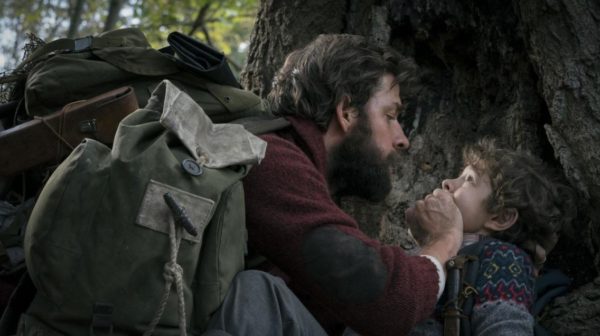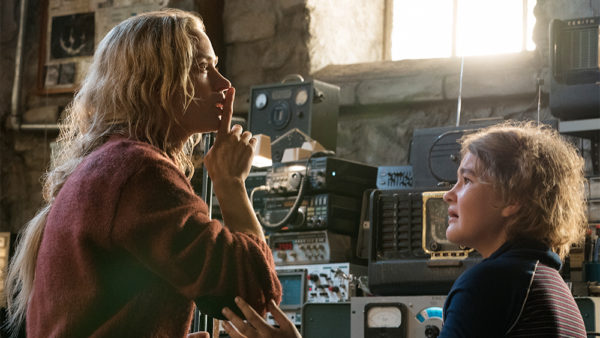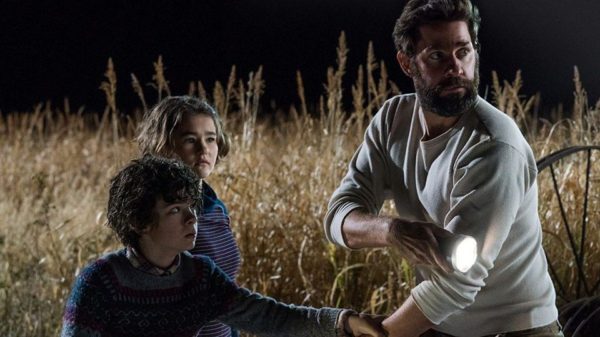A Quiet Place Review
A winning concept can completely carry a genre film, and “A Quiet Place” has exactly that. Bryan Woods and Scott Beck’s idea of a family that must live in total silence in order to survive a monster/alien threat is the rare seed for a story that can blossom into an enthralling moviegoing experience. John Krasinski, as a writer, director and star, simply nurses “A Quiet Place” into a fuller, more deeply rooted film.
The most essential element of successfully developing a concept movie is keeping the scale small and scope tight, and “A Quiet Place” nails that. Trusting that the viewer needs no explanation of where these sound-hunting creatures came from to understand what’s at stake, Krasinski need only focus on the central characters and how they are handling their dire circumstances.
Krasinski and real-life wife Emily Blunt play a husband and wife who in the wake of this apocalyptic incident have figured out what it takes to survive with their three kids when tragedy strikes unexpectedly. Fast forward more than a year later, we see how the family has adapted to life in silence, cleverly “sound-proofing” their home yet going about their business on a razor’s edge. Oh, and the mother is pregnant and due in a matter of weeks.
The script and Krasinski realize this silent world thoughtfully with small meaningful touches like the kids playing Monopoly with felted pieces and tokens subbed out for soft materials, a simple way of communicating the need for life to go on in spite of everything. The oldest child, played by Millicent Simmonds, is deaf, and yet in a world where hearing matters less, her father has been desperately trying to build her a cochlear implant.
The film is steeped in these family values, presumably something Krasinski, as a relatively new father, brought to the table. Among the minimal lines of dialogues is a consistent theme of familial responsibility and the desperation of these parents to protect their children. At its core, the story is really about that powerful parental fear of not being able to keep your children safe and the consequent drive to protect them. Everything else, including the silence component, is layered on top.
The “gimmick” of silence, however, provides these rich storytelling opportunities and also really forces the viewer to engage with the film differently than most standard-order horror flicks or monster thrillers. Like anyone deprived of one sense learns to compensate with others, we pay much closer attention to the visuals. Krasinski uses this opportunity to invite us deeper into the story and into the characters shoes (though, obviously, they don’t wear shoes).
That invitation can also be risky and open up logic problems in the plot, but “A Quiet Place” remains eminently engaging anyway, keeping us in constant suspense and dread. After all, all these characters can do is try not to make a sound and simply stay alive — there isn’t much room for optimism or a solution. The plot smartly builds around close-calls, moments of tension between family members and the few moments of release. When the father takes the son (Noah Jupe) out on a day trip in hopes of imparting some survival wisdom onto him, they get one such moment to breathe easy, which would play as cheesy in most films but makes a great deal of sense here.
These moments are also moments of reprieve for the audience, and if that audience is in a movie theater, you become very conscious of every shift in your seat and every bite of popcorn making even the slightest noise. Considering how often we are bombarded with big-scale noisy films that think they’re delivering an immersive movie experience, it’s remarkable that this film takes the entirely opposite approach and actually provides twice the transporting mental, physical and emotional thrills.
“A Quiet Place” isn’t entirely silent; in fact, one of its few flaws is the exaggerated sound editing and scoring when a noise actually does occur, usually in an attempt to amplify a jump scare. The film can’t resist utilizing horror genre cliches in this way and others, but it’s a small price to pay for an otherwise exciting film (and horror fans will probably appreciate the familiarity of these tactics).
Although not quite as dramatically potent, “A Quiet Place” shares a lot of similarities with “10 Cloverfield Lane” in keeping the viewer in the dark about the greater context surrounding a story and instead focusing on a claustrophobic character-driven scenario. The films even have similar endings tonally speaking. Without spoiling anything, “A Quiet Place” ends on one of the most satisfying notes in recent movie memory, the perfect form of cinematic punctuation on an unforgettable film experience.
4.5/5 Stars
A Quiet Place
Directed by John Krasinski
Written by Bryan Woods and Scott Beck, John Krasinski
Starring: John Krasinski, Emily Blunt, Millicent Simmonds, Noah Jupe







0 Comments
You can be the first one to leave a comment.